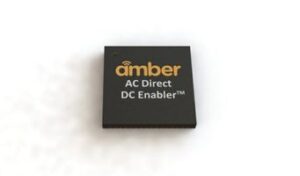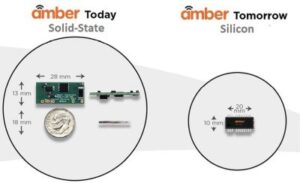Here’s the rub when it comes to modernizing the outlets, switches and circuit breakers that characterize ac electrical systems: Any innovations must interoperate with an installed base of equipment that may have been in place for decades. Manufacturers say issues surrounding compatibility with installed equipment have slowed the rate of introduction for technologies such as the internet of things (IoT) and intelligent controls.

But this situation may be changing thanks to advances in solid-state controls. One example of the trend comes from Amber Solutions via an alliance with Infineon Technologies. The two have devised a system-on-a-chip (SoC) for power management small enough to be easily integrated into the form factors of existing electrical equipment such as an ordinary ac outlet box.
The SoC enables the design of endpoints that include any number of IoT communication components. The resulting products are said to deliver fully-connected smart building intelligence that makes use of existing gang boxes and circuit breaker panels. This SoC, for example, is claimed to imbue light switches, outlets, and circuit breakers with enough processing power to handle up to 10 times the sensing capabilities and smart features of currently available smart switches and outlets.
Amber says its technology today resides on a 13×28-mm PCB. It claims the next generation will fit on a 10×20-mm chip package. The technology can be viewed basically as a combination ac-to-dc supply plus a smart switch. Output power ranges from 0.2 to 15 W, drawn from input voltage that spans 50 to 480 V. The on-demand output voltage can be 3.3 V, 5 V, 12 V, or anything in between. Power density comes in at 5 W/in3, with built-in short circuit, over-voltage, and thermal protection.

The technology includes a built-in power signature identifier that notices electrical anomilies such as arcing. That’s because Amber chips essentially digitize the sine wave at kilohertz rates using proprietary software/firmware and algorithms, giving the technology awareness as to the electrical sine wave’s “normal” state at all times. This awareness lets it detect anomalies such as a forming arc-fault literally the instant the anomaly occurs. The technology then follows the anomaly downstream within a single cycle (or within multiple half cycles if needed). If the anomaly repeats—even in one complete cycle or a cycle and a half—the system recognizes it as a true arc and trips.

Amber says the presense of integrated wireless communications allows an Amber-powered circuit breaker to provide immediate data on a specific endpoint that caused a trip. Such data can include the character of the trip (slow-trip, dead short, etc.) and enable wireless shut off or resetting.
However, for anomalies that don’t repeat after a single cycle, the system allows electricity to flow, virtually eliminating nuisance trips. All in all, Amber’s embedded intelligence operates quickly and with enough deep understanding of electrical waveforms to virtually eliminate false and nuisance GFCI and AFCI trips.
The switching is solid state and hence arc free; thus it requires no special measures for the switching of capacitive or inductive loads. And it is configurable for SPST or SPDT. Amber also says it has a special version of its ac switch for driving LEDs.
The new SoC can be contrasted with conventional solid state relays (SSRs). SSRs switch electrical power using optically coupled photovoltaic and semiconductor-controlled rectifiers (SCRs or Triacs). The conventional SSR is inefficient—for every 1 A of the current it handles, it dissipates 1.4 W; thus a 10-A SSR dissipates 14 W. Conventional SSRs also turn on and off slowly and have a large mechanical footprint.
Perhaps most important, conventional SCRs and Triacs used in SSRs don’t control power to the load on a cycle-by-cycle basis. When modulating power—as for example in conventional light dimmers–they typically do so by turning on for some fraction of the ac cycle.
In contrast, the Amber solid state switch does handle power cycle-by-cycle rather than blocking portions of the ac waveform within each cycle. It is integrated with what’s called a dedicated ac-dc enabler. The enabler basically extracts dc directly from the ac mains for powering the SoC.
Amber says its solid state switch is designed to provide multiple control functions such as lighting control/dimming, over-voltage surge protection, over-current capacitive load protection, and over-voltage inductive load reaction. It also dissipates a relatively minescule fraction of milliwatt for every amp of current it handles.
The presense of integrated wireless communications allows an Amber-powered circuit breaker to provide immediate data on a specific endpoint that caused a trip. Such data can include the character of the trip (slow-trip, dead short, etc.) and enable wireless shut off or resetting.
Wall outlets and light switches can incorporate Amber’s switch to handle overload and thermal sensing. Moreover, Amber says its chip can also power common dc loads directly such as security sensors, micro cameras, air quality detectors, pressure sensors, wireless transmitters and receivers, and so forth.
Amber expects to be in production next year.






